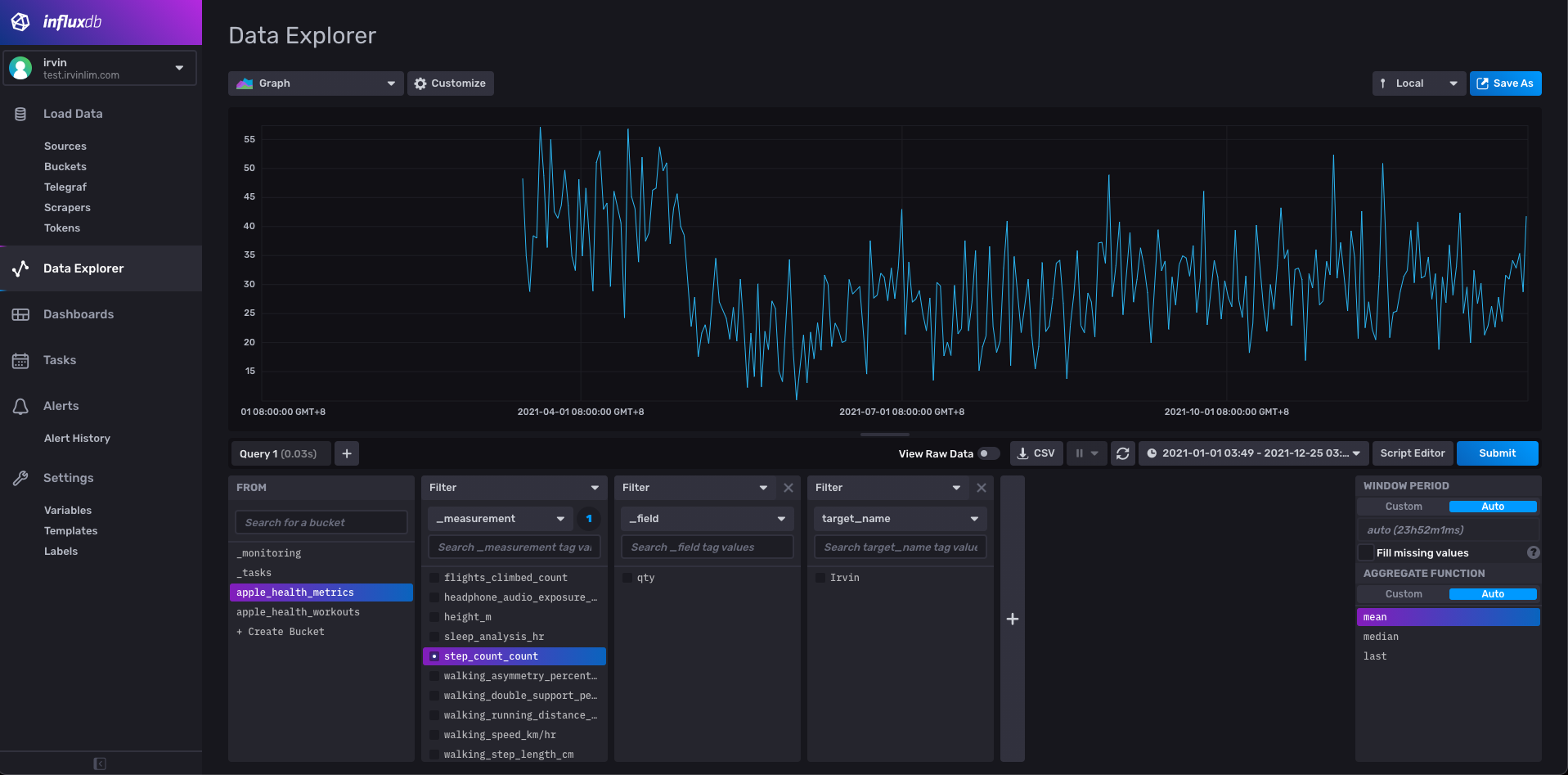Simple HTTP server written in Go that ingests data from Health Auto Export into multiple configurable storage backends.
The Health Auto Export app (https://www.healthexportapp.com) allows you to easily export Apple Health data from your iOS device into a portable format. However, it currently only supports the following export methods:
- iCloud Drive
- REST API
- Home Assistant
- MQTT
As such, this simple HTTP server will receive requests from the Health Auto Export app via the REST API export method, which allows the flexibility to export data into one or more configured backends.
You will first have to download the Health Auto Export iOS app on your iOS device. NOTE: You will need to purchase Premium, or use the free trial to enable Automations.
In the app, create a new Automation (detailed instructions here):
- Under Automation Type, select
REST API. - Enter the URL to your server (see below for instructions on how to run the server).
- The URL should look like
http://your.domain/api/healthautoexport/v1/influxdb/ingest - Optional: To identify the source of data (i.e. the person's whose health is being tracked), add
?target=NAMEto the end of the URL, whereNAMEis a friendly name such asJohn. This will enable target name tracking in the ingester.
- The URL should look like
- Under Export format, select
JSON. - You can optionally choose which Health Metrics and/or Workouts to send.
- Under Manual Sync, you can select a time range, and click "Export" to test if it is working.
You only need go to build the server.
$ go build -o build/ingester ./cmd/ingester/....
$ ./build/ingester --help
Usage of ./build/ingester:
--backend.influxdb Enable the InfluxDB storage backend.
--backend.localfile Enable the LocalFile storage backend.
--http.authToken string Optional authorization token that will be used to authenticate incoming requests.
--http.certFile string Certificate file for TLS support.
--http.enableTLS Enable TLS/HTTPS. Requires setting certificate and key files.
--http.keyFile string Key file for TLS support.
--http.listenAddr string Address to listen on. (default ":8080")
--influxdb.authToken string Auth token to connect to InfluxDB.
--influxdb.insecureSkipVerify Skip TLS verification of the certificate chain and host name for the InfluxDB server.
--influxdb.metricsBucketName string InfluxDB bucket name for metrics.
--influxdb.orgName string InfluxDB organization name.
--influxdb.serverURL string Server URL for InfluxDB.
--influxdb.staticTags strings Additional tags to add to InfluxDB for every single request, in key=value format.
--influxdb.workoutsBucketName string InfluxDB bucket name for workouts.
--localfile.metricsPath string Output path to write metrics, with one metric per file. All data will be aggregated by timestamp. Any existing data will be merged together.$ docker pull irvinlim/apple-health-ingesterhttp.listenAddr: Address to listen on. (default ":8080")http.authToken: Optional authorization token that will be used to authenticate incoming requests.
- URL:
/api/healthautoexport/v1/localfile/ingest
Writes the ingested payloads into the local filesystem as JSON. Mainly intended to be used for debugging purposes, but the logic could be easily extended for file backups on a remote file store (e.g. S3, Dropbox, etc).
This backend is disabled by default. You can enable it by specifying --backend.localfile.
You must also configure additional fields for the backend to work. Example configuration:
$ ingester \
--backend.localfile \
--localfile.metricsPath=/data/health-export-metricsNOTE: Workout data is currently not yet supported for this storage backend.
This will produce a directory with each metric stored as a separate file as follows:
$ ls -la /data/health-export-metrics
total 2604
drwxr-xr-x 96 irvin 3072 Dec 25 00:15 .
drwxr-xr-x 3 irvin 96 Dec 25 00:11 ..
-rw-r--r-- 1 irvin 418389 Dec 25 00:19 active_energy_kJ.json
-rw-r--r-- 1 irvin 30279 Dec 25 00:19 apple_exercise_time_min.json
-rw-r--r-- 1 irvin 4755 Dec 25 00:19 apple_stand_hour_count.json
-rw-r--r-- 1 irvin 124346 Dec 25 00:19 apple_stand_time_min.json
-rw-r--r-- 1 irvin 72 Dec 25 00:19 basal_body_temperature_degC.json
-rw-r--r-- 1 irvin 851170 Dec 25 00:19 basal_energy_burned_kJ.json
...If target name is specified during export, then the filename will be prefixed with the target name.
- URL:
/api/healthautoexport/v1/influxdb/ingest
Writes the ingested metrics and workout data into a configured InfluxDB backend.
This backend is disabled by default. You can enable it by specifying --backend.influxdb.
You must also configure additional fields for the backend to work. Example configuration:
$ ingester \
--backend.influxdb \
--influxdb.serverURL=http://localhost:8086 \
--influxdb.authToken=INFLUX_API_TOKEN \
--influxdb.orgName=my-org \
--influxdb.metricsBucketName=apple_health_metrics \
--influxdb.workoutsBucketName=apple_health_workoutsAll metrics will be stored in the bucket named by --influxdb.metricsBucketName using the following format:
- Measurement:
- Metric name (e.g.
active_energy) + Unit (e.g.kJ) - Example:
active_energy_kJ
- Metric name (e.g.
- Fields:
- Most metrics will use
qtyfor field name. - Some metrics which have multiple fields will use their corresponding field name. For example,
sleep_analysis_hruses the following field names:inBedinBedStartinBedEndinBedSource- The rest of the fields can be found here: https://github.com/Lybron/health-auto-export/wiki/API-Export---JSON-Format
- Most metrics will use
- Tags:
target_name: Optional, set by?target=TARGET_NAMEquery string from HTTP request.- Additional tags can be set by
--influxdb.staticTags.
Workout data will be stored in the bucket named by --influxdb.workoutsBucketName. Workout data is slightly more complicated than metrics. You can read more about the workout data format here: https://github.com/Lybron/health-auto-export/wiki/API-Export---JSON-Format#workouts
There are two kinds of data:
- Workout summary data: Contains aggregate statistics about each workout (i.e. one point per workout)
- Measurement:
workout - Fields:
- Example:
activeEnergy_kJ
- Example:
- Timestamp: Uses the workout's start time
- Measurement:
- During-workout time-series data: Contains per-minute granularity time-series data
- Measurement: Currently, only the following measurements are supported for this type of data:
heart_rate_data_bpm- Fields:
qty
- Fields:
heart_rate_recovery_bpm- Fields:
qty
- Fields:
route- Fields:
lat,lon,altitude
- Fields:
- Timestamp: Corresponds to the
date/timestampfield
- Measurement: Currently, only the following measurements are supported for this type of data:
All workout data have the following tags:
- Tags:
target_name: Optional, set by?target=TARGET_NAMEquery string from HTTP request.workout_name: Name of the workout.- Example
Walking
- Example
- Additional tags can be set by
--influxdb.staticTags.
MIT




